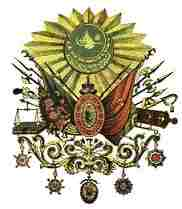Ottoman Empire/Temp
|
|
This is the temporary editing (TEMP) file for the Ottoman Empire entry. Use the talk page of the Ottoman Empire entry.
| ||
| National motto: | ||
| [PLACE MAP] | ||
| Official language | Ottoman Turkish | |
| Capital | İstanbul (Constantinople) | |
| Sovereigns | Sultans of the Osmanli Dynasty | |
| Establishment | 1281 | |
| Dissolution | October 29 1923 | |
| Currency | Akçe | |
| The Ottoman Flag |  | |
| Part of the History of Turkey | ||
The Ottoman Empire was a Turkish state in the Middle East that comprised Turkey, part of Southwest Asia, North Africa and south-eastern Europe in the 14th to 20th centuries, established by a tribe of Oghuz Turks in western Anatolia. The Ottoman Empire was among the world's most powerful polities in the 16th and 17th centuries when the nations of Europe felt threatened by its steady advance through the Balkans.
The Empire was founded by Osman I (in Arabic Uthmān, hence the name Ottoman Empire). It sometimes referred to in diplomatic circles as the "Sublime Porte" or simply as "the Porte", due to the greeting ceremony the sultan held for foreign ambassadors at the Palace Gate. It is also referring to the Ottoman Empire being the gateway between Europe and Asia. The capital was from 1453 Constantinople, in Turkish İstanbul.
| Contents |
History
Main article: History of the Ottoman Empire
The Ottoman Empire was founded by Osman I in 1281. As sultan Mehmed II conquered Constantinople (Istanbul) in 1453, the state grew into a mighty empire. The Empire reached its apex under Suleiman the Magnificent in the 16th century when it stretched from the Persian Gulf in the east to Hungary in the northwest; and from Egypt in the south to the Caucasus in the north. After its defeat at the Battle of Vienna in 1683, however, the empire began a slow decline, culminating in the defeat of the empire by the Allies in World War I.
State organisation
Main article: State organisation of the Ottoman Empire
Ottoman state organisation was based on a hierarchy with the sultan in the top and below him his viziers, other court officials and military commanders.
Culture
Main article: Culture of the Ottoman Empire
The Ottoman Turks had a high tolerance of alien cultures and religions, at least with medieval measures. Early on as the Turks drew out the Byzantine from Anatolia and later pursued them into Europe, it was a part of the Jihad (or Holy War) against Christianity and the first Ottoman rulers called themselves Gazi, Holy Warrior. But, as the Ottomans moved further west and the assimilation of the Greek and Balkan culture progressed, the Turkic leaders themselves absorbed some of the culture of the conquered people. The alien culture was gradually added to the Turks' own creating the characteristic Ottoman culture. After the capturing of Constantinople in 1453, most churches were left intact and only a few (including, of course, Hagia Sophia) were turned into mosques. The Ottoman court life in many aspects assembled ancient traditions of the Persian Shah's, but had many Greek and European influences. For centuries, the Ottoman Empire was the refuge of the Jews of Europe.
Military
Main article: Military of the Ottoman Empire
The Ottoman military was a complex system of recruiting and fief-holding. In the Ottoman army, light cavalry long formed the core and they were given fiefs called timars. Cavalry used bows and short swords and made use of nomad tactics similar to those of the Mongol Empire. Even though, the Ottoman army was once among the most advanced fighting forces in the world, and one of the first to employ muskets. The famous Janissary corps provided elite troops and bodyguard for the sultan. However, after the 17th century, the Ottoman could no longer produce a modern fighting force because of lack of reforms, mainly because of the corrupted Janissaries. The abolition of the corps in 1826 was not enough and in the war against Russia, the Ottoman Empire severely lacked modern weapons and technologies.
Provinces
Main article: Provinces of the Ottoman Empire
At the height of its power, the Ottoman Empire had 29 provinces plus three tributary principalities and Transsylvania, a kingdom sworn allegiance to the Porte.
Sultans
Main article: Osmanli Dynasty
The sultan dynasty was the sole regent and government of the empire, at least officially. The dynasty is most often called the Osmanli. The sultan enjoyed many titles such as Sovereign of the House of Osman, Sultan of Sultans, Khan of Khans, Commander of the Faithful and Successor of the Prophet of the Lord of the Universe. Note that the first rulers never called themselves sultans, but rather beys. See the article on State Organisation of the Ottoman Empire for further information on the sultan and the structure of power.
|
|

